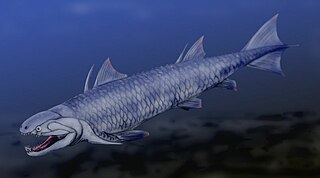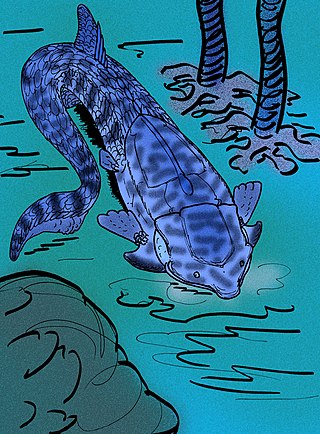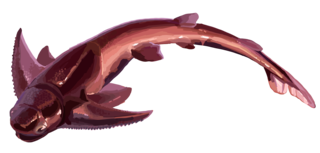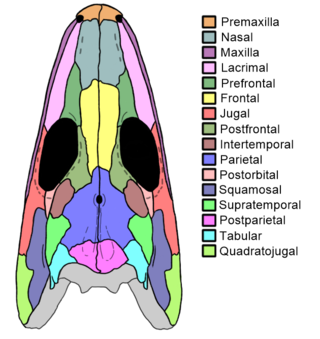
Chondrichthyes is a class of jawed fish that contains the cartilaginous fish or chondrichthyians, which all have skeletons primarily composed of cartilage. They can be contrasted with the Osteichthyes or bony fish, which have skeletons primarily composed of bone tissue. Chondrichthyes are aquatic vertebrates with paired fins, paired nares, placoid scales, conus arteriosus in the heart, and a lack of opecula and swim bladders. Within the infraphylum Gnathostomata, cartilaginous fishes are distinct from all other jawed vertebrates.

The Silurian is a geologic period and system spanning 24.6 million years from the end of the Ordovician Period, at 443.8 million years ago (Mya), to the beginning of the Devonian Period, 419.2 Mya. The Silurian is the shortest period of the Paleozoic Era. As with other geologic periods, the rock beds that define the period's start and end are well identified, but the exact dates are uncertain by a few million years. The base of the Silurian is set at a series of major Ordovician–Silurian extinction events when up to 60% of marine genera were wiped out.

Gnathostomata are the jawed vertebrates. Gnathostome diversity comprises roughly 60,000 species, which accounts for 99% of all living vertebrates, including humans. In addition to opposing jaws, living gnathostomes have true teeth, paired appendages, the elastomeric protein of elastin, and a horizontal semicircular canal of the inner ear, along with physiological and cellular anatomical characters such as the myelin sheaths of neurons, and an adaptive immune system that has the discrete lymphoid organs of spleen and thymus, and uses V(D)J recombination to create antigen recognition sites, rather than using genetic recombination in the variable lymphocyte receptor gene.

Acanthodii or acanthodians is an extinct class of gnathostomes. They are currently considered to represent a paraphyletic grade of various fish lineages basal to extant Chondrichthyes, which includes living sharks, rays, and chimaeras. Acanthodians possess a mosaic of features shared with both osteichthyans and chondrichthyans. In general body shape, they were similar to modern sharks, but their epidermis was covered with tiny rhomboid platelets like the scales of holosteians.

Placodermi is a class of armoured prehistoric fish, known from fossils, which lived from the Silurian to the end of the Devonian period. Their head and thorax were covered by articulated armoured plates and the rest of the body was scaled or naked, depending on the species. Placoderms were among the first jawed fish; their jaws likely evolved from the first of their gill arches.

Galeaspida is an extinct taxon of jawless marine and freshwater fish. The name is derived from galea, the Latin word for helmet, and refers to their massive bone shield on the head. Galeaspida lived in shallow, fresh water and marine environments during the Silurian and Devonian times in what is now Southern China, Tibet and Vietnam. Superficially, their morphology appears more similar to that of Heterostraci than Osteostraci, there being currently no evidence that the galeaspids had paired fins. A galeaspid Tujiaaspis vividus from the Silurian period of China was described in 2022 as having a precursor condition to the form of paired fins seen in Osteostraci and gnathostomes. Earlier than this, Galeaspida were already in fact regarded as being more closely related to Osteostraci, based on the closer similarity of the morphology of the braincase.

Arthrodira is an order of extinct armored, jawed fishes of the class Placodermi that flourished in the Devonian period before their sudden extinction, surviving for about 50 million years and penetrating most marine ecological niches. Arthrodires were the largest and most diverse of all groups of placoderms.

Psarolepis is a genus of extinct bony fish which lived around 397 to 418 million years ago. Fossils of Psarolepis have been found mainly in South China and described by paleontologist Xiaobo Yu in 1998. It is not known certainly in which group Psarolepis belongs, but paleontologists agree that it probably is a basal genus and seems to be close to the common ancestor of lobe-finned and ray-finned fishes. In 2001, paleontologist John A. Long compared Psarolepis with onychodontiform fishes and refer to their relationships.
The Xitun Formation is a palaeontological formation which is named after Xitun village in Qujing, a location in South China. This formation includes many remains of fossilized fish and plants of the Early Devonian period. It was originally referred to as the Xitun Member of the Cuifengshan Formation.

Incisoscutum is an extinct genus of arthrodire placoderm from the Early Frasnian Gogo Reef, from Late Devonian Australia. The genus contains two species I. ritchiei, named after Alex Ritchie, a palaeoichthyologist and senior fellow of the Australian Museum, and I. sarahae, named after Sarah Long, daughter of its discoverer and describer, John A. Long.
Guiyu oneiros is one of the earliest articulated bony fish discovered. Fossils of Guiyu have been found in what is now Qujing, Yunnan, China, in late Silurian marine strata, about 425 million years old.

Silurolepis platydorsalis is a species of Silurian-aged "maxillate" early placoderm that has been described from (mostly) articulated remains. Although it has been known for several years, it was finally described by Zhang, et al., in 2010.

Entelognathus primordialis is a early placoderm from the late Silurian of Qujing, Yunnan, 419 million years ago.

Romundina is a small, heavily armored extinct genus of acanthothoracid placoderms which lived in shallow marine environments in the early Devonian (Lochkovian). The name Romundina honors Canadian geologist and paleontologist Dr. Rómundur (Raymond) Thorsteinsson of Calgary, Alberta, Canada. Romundina are believed to have lived on Earth between 400 and 419 million years ago. The closest known relative to Romundina is the acanthothoracid Radotina. The type and only described species is R. stellina.

Megamastax is a genus of lobe-finned fish which lived during the late Silurian period, about 423 million years ago, in China. Before the discovery of Megamastax, it was thought that jawed vertebrates (gnathostomes) were limited in size and variation before the Devonian period. Megamastax is known only from jaw bones and it is estimated that it reached about 1 metre long.

Qilinyu is a genus of early placoderm from the late Silurian of China. It contains a single species, Qilinyu rostrata, from the Xiaoxiang fauna of the Kuanti Formation. Along with its contemporary Entelognathus, Qilinyu is an unusual placoderm showing some traits more similar to bony fish, such as dermal jaw bones and lobe-like fins. It can be characterized by adaptations for a benthic lifestyle, with the mouth and nostrils on the underside of the head, similar to the unrelated antiarch placoderms. The shape of the skull has been described as "dolphin-like", with a domed cranium and a short projecting rostrum.

Kujdanowiaspis is an extinct genus of arthrodire placoderm fish from the Early Devonian of Podolia (Ukraine), Poland and Spain. Kujdanowiaspis is known from many fragmentary head shields and body armours.

The Intertemporal bone is a paired cranial bone present in certain sarcopterygians and extinct amphibian-grade tetrapods. It lies in the rear part of the skull, behind the eyes.

Bianchengichthys is a genus of maxillate placoderm fish from the late Silurian Period. Its fossils have been recovered from Yunnan Province, China, and it is represented by only one species: Bianchengichthys micros.

Qianodus is a jawed vertebrate genus that is based on disarticulated teeth from the lower Silurian of China. The type and only species of Qianodus, Q. duplicis, is known from compound dental elements called tooth whorls, each consisting of multiple tooth generations carried by a spiral-shaped base. The tooth whorls of Qianodus represent the oldest unequivocal remains of a toothed vertebrate, predating previously recorded occurrences by about 14 million years. The specimens attributed to the genus come from limestone conglomerate beds of the Rongxi Formation exposed near the village of Leijiatun, Guizhou Province, China. These horizons have been interpreted as tidal deposits1 that form part of the shallow marine sequences of the Rongxi Formation.



















